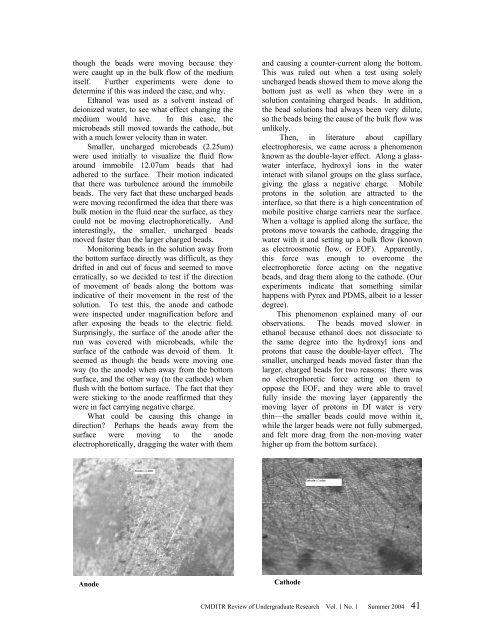CMDITR Review of Undergraduate Research - Pluto - University of ...
CMDITR Review of Undergraduate Research - Pluto - University of ...
CMDITR Review of Undergraduate Research - Pluto - University of ...
You also want an ePaper? Increase the reach of your titles
YUMPU automatically turns print PDFs into web optimized ePapers that Google loves.
though the beads were moving because they<br />
were caught up in the bulk flow <strong>of</strong> the medium<br />
itself. Further experiments were done to<br />
determine if this was indeed the case, and why.<br />
Ethanol was used as a solvent instead <strong>of</strong><br />
deionized water, to see what effect changing the<br />
medium would have. In this case, the<br />
microbeads still moved towards the cathode, but<br />
with a much lower velocity than in water.<br />
Smaller, uncharged microbeads (2.25um)<br />
were used initially to visualize the fluid flow<br />
around immobile 12.07um beads that had<br />
adhered to the surface. Their motion indicated<br />
that there was turbulence around the immobile<br />
beads. The very fact that these uncharged beads<br />
were moving reconfirmed the idea that there was<br />
bulk motion in the fluid near the surface, as they<br />
could not be moving electrophoretically. And<br />
interestingly, the smaller, uncharged beads<br />
moved faster than the larger charged beads.<br />
Monitoring beads in the solution away from<br />
the bottom surface directly was difficult, as they<br />
drifted in and out <strong>of</strong> focus and seemed to move<br />
erratically, so we decided to test if the direction<br />
<strong>of</strong> movement <strong>of</strong> beads along the bottom was<br />
indicative <strong>of</strong> their movement in the rest <strong>of</strong> the<br />
solution. To test this, the anode and cathode<br />
were inspected under magnification before and<br />
after exposing the beads to the electric field.<br />
Surprisingly, the surface <strong>of</strong> the anode after the<br />
run was covered with microbeads, while the<br />
surface <strong>of</strong> the cathode was devoid <strong>of</strong> them. It<br />
seemed as though the beads were moving one<br />
way (to the anode) when away from the bottom<br />
surface, and the other way (to the cathode) when<br />
flush with the bottom surface. The fact that they<br />
were sticking to the anode reaffirmed that they<br />
were in fact carrying negative charge.<br />
What could be causing this change in<br />
direction? Perhaps the beads away from the<br />
surface were moving to the anode<br />
electrophoretically, dragging the water with them<br />
and causing a counter-current along the bottom.<br />
This was ruled out when a test using solely<br />
uncharged beads showed them to move along the<br />
bottom just as well as when they were in a<br />
solution containing charged beads. In addition,<br />
the bead solutions had always been very dilute,<br />
so the beads being the cause <strong>of</strong> the bulk flow was<br />
unlikely.<br />
Then, in literature about capillary<br />
electrophoresis, we came across a phenomenon<br />
known as the double-layer effect. Along a glasswater<br />
interface, hydroxyl ions in the water<br />
interact with silanol groups on the glass surface,<br />
giving the glass a negative charge. Mobile<br />
protons in the solution are attracted to the<br />
interface, so that there is a high concentration <strong>of</strong><br />
mobile positive charge carriers near the surface.<br />
When a voltage is applied along the surface, the<br />
protons move towards the cathode, dragging the<br />
water with it and setting up a bulk flow (known<br />
as electroosmotic flow, or EOF). Apparently,<br />
this force was enough to overcome the<br />
electrophoretic force acting on the negative<br />
beads, and drag them along to the cathode. (Our<br />
experiments indicate that something similar<br />
happens with Pyrex and PDMS, albeit to a lesser<br />
degree).<br />
This phenomenon explained many <strong>of</strong> our<br />
observations. The beads moved slower in<br />
ethanol because ethanol does not dissociate to<br />
the same degree into the hydroxyl ions and<br />
protons that cause the double-layer effect. The<br />
smaller, uncharged beads moved faster than the<br />
larger, charged beads for two reasons: there was<br />
no electrophoretic force acting on them to<br />
oppose the EOF, and they were able to travel<br />
fully inside the moving layer (apparently the<br />
moving layer <strong>of</strong> protons in DI water is very<br />
thin—the smaller beads could move within it,<br />
while the larger beads were not fully submerged,<br />
and felt more drag from the non-moving water<br />
higher up from the bottom surface).<br />
Anode<br />
Cathode<br />
<strong>CMDITR</strong> <strong>Review</strong> <strong>of</strong> <strong>Undergraduate</strong> <strong>Research</strong> Vol. 1 No. 1 Summer 2004 41




